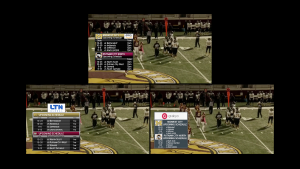AWS, LTN, Grabyo Sports Production Test Shows Potential for CDI Cloud-Based Production
Story Highlights
In September AWS rolled its Cloud Digital Interface (CDI), a network technology that, thanks to a software development kit, will allow for Amazon partners to build live video solutions in the cloud, opening up a whole host of new ways for sports content to be produced and distributed. And a proof of concept involving AWS, LTN, and Grabyo at a football game in California earlier this month was a hint of what is to come. “This was the first time we were able to do a full end-to-end and live sports workflow,” says David Griggs, Senior Product Manager, AWS Elemental.

A production test of AWS CDI with Grabyo and LTN showed how the cloud can be used to create three separate outputs from one feed.
The test involved camera signals sent from a football stadium via LTN Transport to a production facility in Kansas City where they were used to create a clean feed. That clean feed was then sent to CDI via AWS MediaConnect and AWS MediaLive where Grabyo, also operating on the AWS CDI, produced three outputs with three different graphical looks thanks to Singular Live. Those three feeds were then sent back out via LTN for distribution.
Colin Moran, VP of Product Management, LTN Create, says the LTN Flex centralized production infrastructure was used to create the clean feed. An LTN cloud-based router, for example, allows for unlimited sources to be distributed where needed, and with Amazon CDI, uncompressed live video signals can easily be delivered to a variety of cloud-based production tools.
“The number of variations of this is limitless,” he says. “We could be creating tens, if not potentially hundreds, of different variations from this production output in the future.”
Gareth Capon, CEO, Grabyo, agrees.
“You are essentially taking one high-fidelity stream and then replicating it three times, moving it into three different production instances with low latency on an uncompressed basis and then repackaging that with different graphics and sending it back over AWS and back into the LTN network for presentation.”
LTN, for example, can take those three feeds and send them to potentially thousands of end points, including local broadcast stations, MVPDs, a virtual MVPD, or other digital and social platforms.
“A very common next step in the process would be to handoff to a copyright protection system which would put in all the protections and then hand it off to a platform downstream,” says Rick Young, SVP & Head of Global Products, LTN Global.
Capon says that the broader opportunity is the demand for live content is only going up and as platforms, devices, and bandwidth get better the demand for high-quality production is also increasing. The challenge is how to do that cost effectively and Griggs says a key benefit of CDI is scalability is far less constrained.
“You can grow and shrink your cloud-based broadcast production infrastructure based on the requirements of the event instead of having to pre-provision for an infrastructure you think you may need in the future,” he adds. “This turns the whole operational paradigm on its head both operationally and commercially.”
Adds Young: “The thing that is super exciting about this is the ability to do just about anything with these workflows which five years ago we all would have been saying ‘someday’ and now we’re doing it.”
